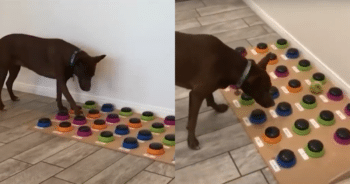Ever wondered what your dog might say if it could talk? Speech pathologist Christina Hunger, MA, CCC-SLP, decided to explore this intriguing question with her dog, Stella. Through her innovative approach, Hunger has successfully taught Stella to understand and use 29 words, forming simple phrases to communicate her needs and observations. This remarkable achievement showcases the potential for deeper communication between humans and their pets. By harnessing the power of Augmentative and Alternative Communication (AAC) technology, Hunger has opened up new possibilities for understanding and interacting with our furry friends.
Christina Hunger, 26, developed a unique method to teach her 18-month-old dog to communicate using a customized Augmentative and Alternative Communication (AAC) system. These devices, typically used with non-verbal children, feature icons representing different words that can be pressed to express thoughts. When activated, the machine vocalizes the word, making communication clear to others. Hunger’s groundbreaking work with Stella demonstrates that dogs, much like humans, can use technology to bridge the communication gap.
When Hunger and her fiancé welcomed a puppy last year, she envisioned the Catahoula/Blue Heeler mix using a similar system to “speak” by pressing buttons. Drawing from her professional expertise, she began teaching Stella to use an AAC device when the puppy was just 8 weeks old. The process started with Hunger observing Stella’s natural behaviors and identifying key moments where communication could enhance their interaction.
In a blog post, Hunger elaborated on the concept of multiple communication methods—verbal speech, gestures, facial expressions, and writing. She emphasized that expressing oneself doesn’t always require spoken words. This understanding laid the foundation for her innovative approach with Stella.
Dogs also have their own expressive communication methods, such as barking, whining, growling, jumping, and sighing. This led Hunger to ponder: “What if we provided dogs with access to the words we use with them daily?” She believed that by offering Stella a way to use words, she could expand the dog’s ability to communicate her needs and emotions more effectively.
Given that dogs can understand and respond to human verbal cues, Hunger tested the idea that they could use the same words via an AAC device. Starting with a word that nearly all dogs recognize—”outside”—Hunger and her fiancé Jake created a button that vocalized the word when pressed. Each time they said “outside” and let Stella out, they pressed the button, hoping Stella would learn to press it herself when she wanted to go out. This consistent modeling helped Stella make the connection between the button and the action.
“After a few weeks of modeling, Stella showed she understood what was happening. When I asked ‘Outside? Stella, want to go outside?’ she began looking at the button, then at me, and barking,” Hunger recounted. This breakthrough indicated that Stella was beginning to grasp the concept of using the button to communicate.
They then introduced other words Stella might need to communicate: eat, water, play, walk, no, come, help, bye, and love you. Each word was carefully selected to meet Stella’s daily needs and social interactions. The training process involved consistent use of the buttons in relevant contexts, reinforcing Stella’s understanding of each word.
“Instead of rewarding Stella with a treat for using a button, we acknowledged her communication and responded accordingly. Stella’s voice and opinions matter as much as ours,” Hunger explained. This approach emphasized the importance of genuine communication rather than mere behavior training.
As Stella’s vocabulary expanded, she began using the buttons independently. “If Jake and I were distracted, Stella started saying ‘play’ repeatedly until we engaged in play. She would say ‘water’ when her bowl was empty. If we hadn’t mentioned a walk after dinner, she would say ‘walk’ multiple times while staring at us. If her toy was stuck under the couch, she would say ‘help’ and stand where she needed us to look. When friends were leaving, she would say ‘bye’ to them,” Hunger detailed. These instances showcased Stella’s growing ability to use language to express her desires and observations.
Stella’s proficiency with the buttons grew, enabling her to comment on situations rather than just request things. For instance, she pressed the “water” button when Hunger was watering plants, even though her own bowl was full. This indicated that Stella was not only using the words for immediate needs but also making observations about her environment.
As Stella continued to learn, something even more remarkable occurred—she began forming phrases from the words. “Stella would say ‘no eat’ or ‘eat no’ if we delayed her meal, ‘walk no’ if we skipped a walk, ‘eat play’ to request her toy filled with food, and ‘help come’ when she needed assistance in another room,” Hunger said. These phrases demonstrated Stella’s ability to combine words to convey more complex messages.
Stella also expressed her displeasure in a sophisticated manner. “When we didn’t feed her dinner early enough, she said ‘love you no’ and walked into another room,” Hunger shared. This level of communication highlighted Stella’s emotional intelligence and her capacity to convey feelings.
While such advanced communication may seem surprising, Hunger reminds us that it’s well-known that the average dog understands about 165 words. Stella’s ability to use an AAC device to express herself not only reinforces this understanding but also opens new possibilities for human-animal communication.
Hunger’s work with Stella is a testament to the potential for innovative approaches in enhancing the bond between humans and their pets. By providing Stella with a means to use words, Hunger has given her dog a voice, illustrating the profound impact of communication in deepening the connection between species.
Click the video below to watch this incredible story!
Please ‘SHARE’ to pass on this story to a friend or family member
The post Speech Pathologist Helps Her Dog Communicate Through Word Buttons appeared first on iHeartDogs.com.

